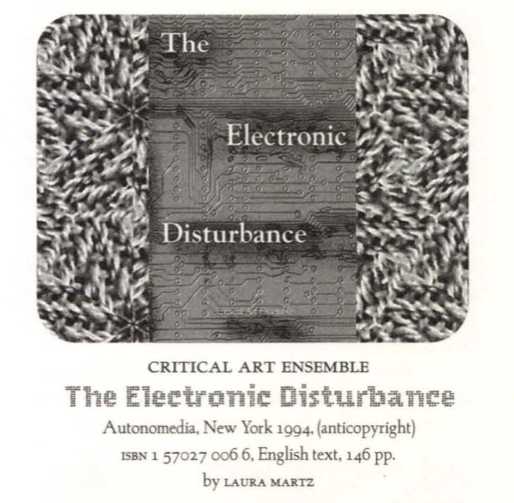This short series of essays from the New Autonomy series is a 'recombinant text' offering a theory of technological resistance in a world where power has moved into an invisible sphere. Critical Art Ensemble are a six-person collective whose multiplicity allows them to range refreshingly across disciplines. Though they appeal to hackers and artists, they are probably mostly to be found bodily somewhere in the academy rather than the street. Resistance is defined here as acting to restore state-usurped power to the individual (which is equated here with political leftism, though it belongs to the libertarian right as well, and called radical, although it does not attack roots, but channels and flow). The cae read power as 'liquid' in postmodernity, reliant on speed of (trans)action; decentralised and disembodied. Attacking it will thus require new tactics.
The CAE locate resistance at the site of virtuality, of electronic data, by the theory that this is where power plays itself out. A spectacular and paralysing information overload is coupled with a dearth of individually empowering information. In the information 'whiteout', there may be access, but the individual must depend on authority to screen and sort. Individuals' 'electronic doubles' are created in data space, surveillable by- and accessible to power.
Acts of resistance are a gamble since they will likely be coopted and dissipate away into the dominant culture; but cae exhort us to 'roll the dice' anyway. Old forms of poetic resistance, however, they warn, are outmoded; appropriation (by power, that is) has killed the old 'certainty of the dialectic'. Old strategies assume power to be fixed and locatable in physical space, and direct their attacks at empty bunkers which are nothing but symbols. Nor should the target be the realm of representation. So protesting in front of the Capitol (or defacing advertisements) won't do it; breaking into their nets and fucking with their data will. The call is to storm the 'bunkers,' both kinds, e- and concrete. Bunkers are nothing more or less than sites of security; panic must be caused, the illusions of security must be disrupted. Resist surveillance; throw noise into the system.
Can technology be diverted to empower the subjects of power? The answer has to do with whether the technology is accepted as a means of passive consumption or as a means for active production. (p.135) Systems for sending, not receiving information, hold the most liberatory promise. A network of resistant 'cells' is powerful because it has too many heads to be killed. When one Internet node is destroyed, traffic flows around it, as impossible to trap as a dissipated gas.
Some readers may find it difficult to overlook the way locating oppression in the 'cyber-elite' ignores physically real forms of oppression which are still very much alive and well, and certainly not doomed to die once the head, so to speak (or the eyes?), is attacked. And the book gets a little precious in places - I'm still not sure of the purpose of the excerpts on 'the virtual' extracted from various fathers (all are men) of modern European thought; inserting the word 'screen' into six otherwise unchanged lines of Dante smells a little of grad student pretension. Critical Art Ensemble are probably likely to appeal most to artists in the academy who have some recent (European) theory and ('high'-)cultural and intellectual history at their disposal.
It might not look much like it used to. But, dispersed as it may be behind its individual terminals, perhaps the American left - if we revise old definitions of it - has still got a few kicks left.
